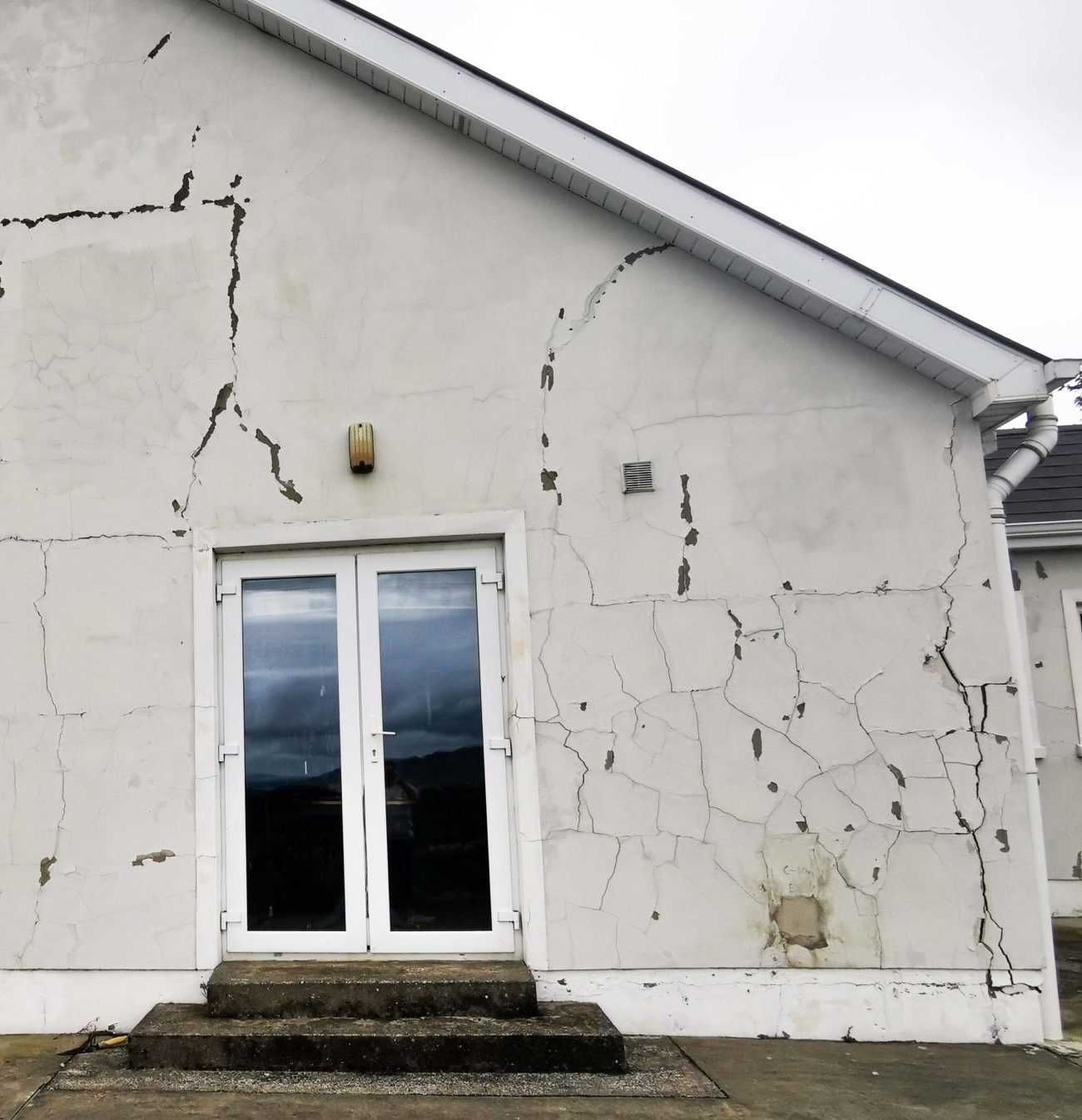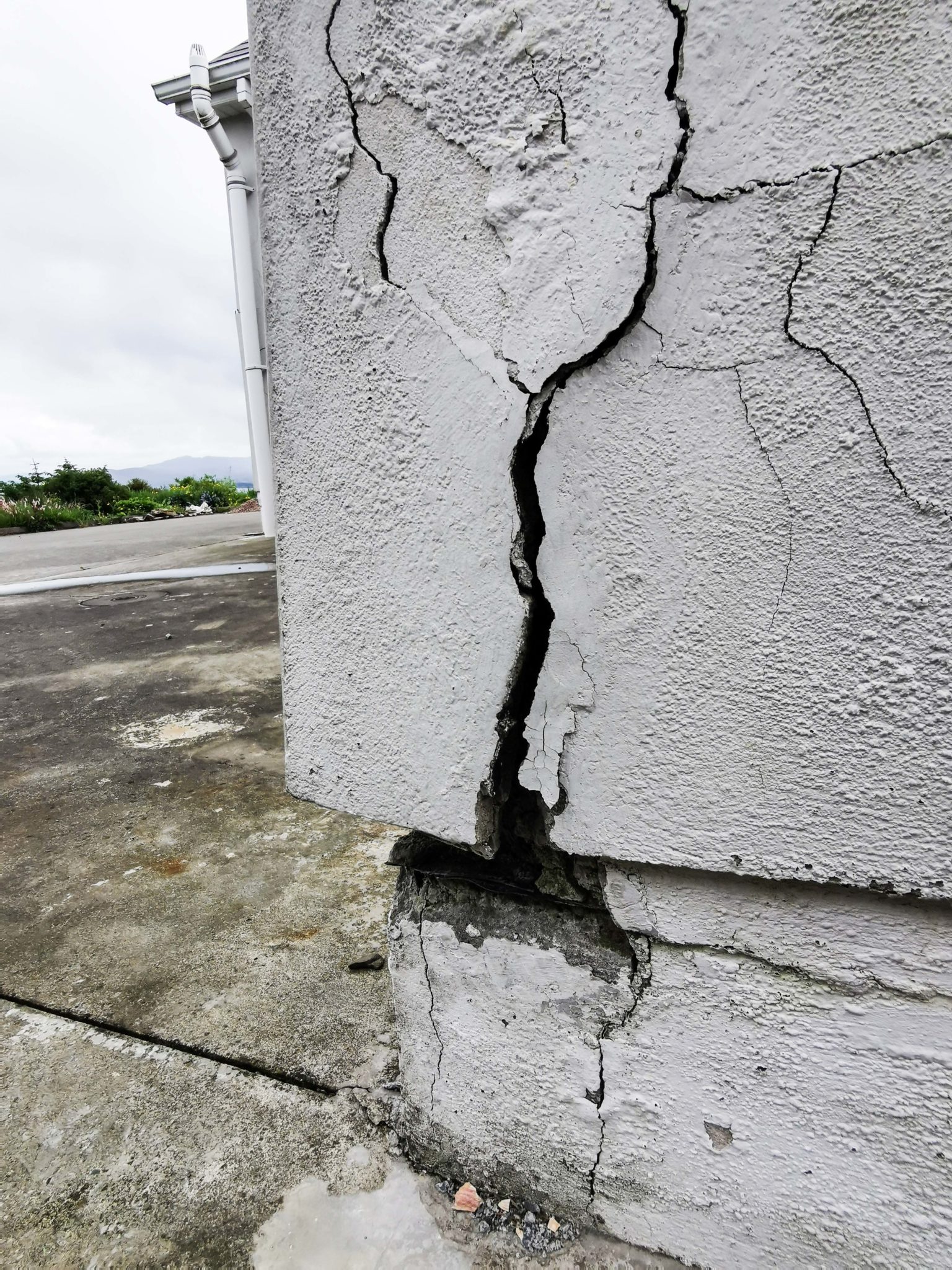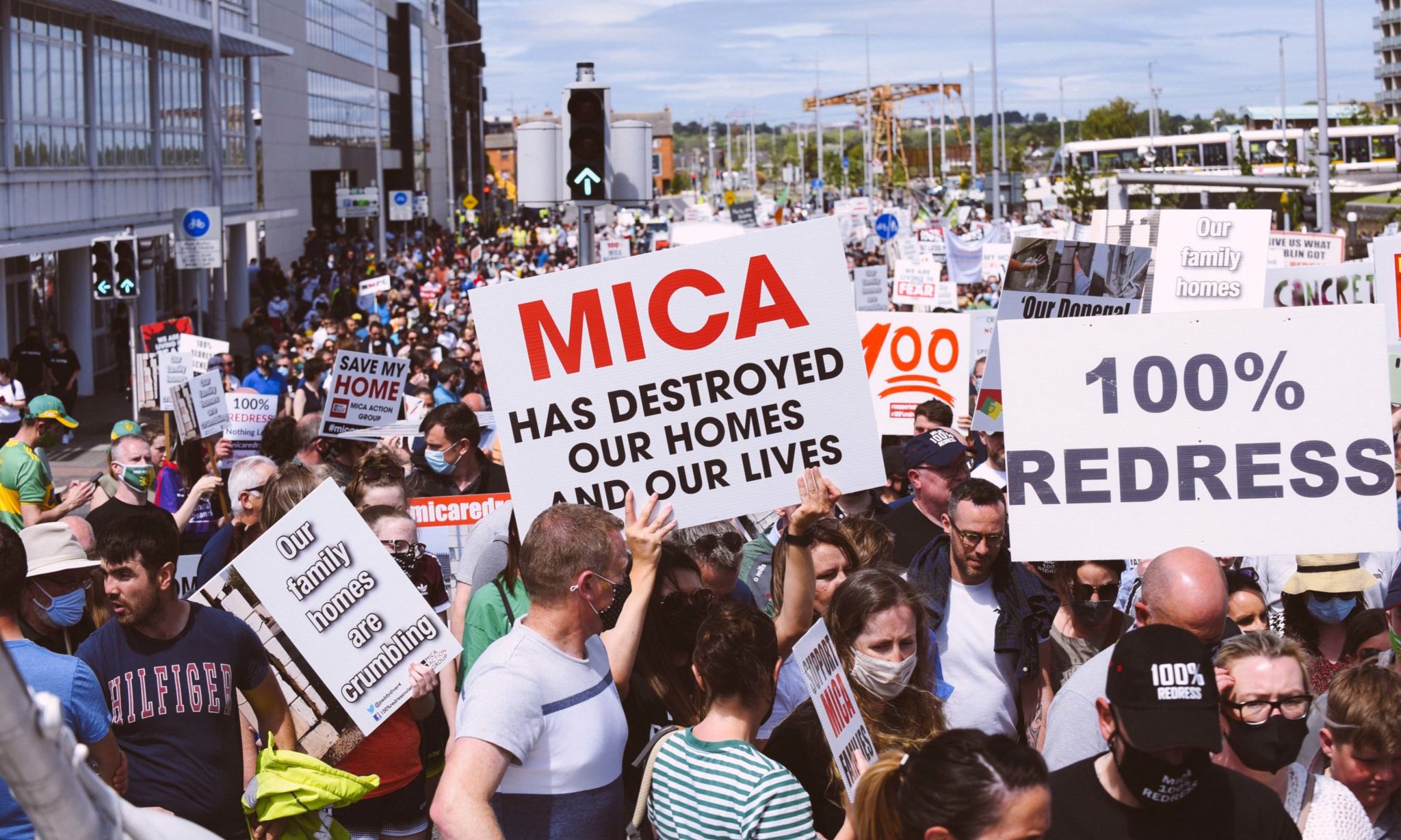- Opinion
- 14 Jul 21
Mica Scandal: "It's Impacting On People's Mental Health"

Claire McDaid, singer with Donegal alt-rock outfit Don’t Fear The Natives, is one of the thousands of people affected by the mica scandal. She tells us about the frightening cracks that are making her home increasingly unsafe – and protesting in Dublin for a 100% redress.
In a video she has sent me, musician Claire McDaid is showing off the fairytale-like view from her home – located on an elevated area outside Buncrana, Donegal, overlooking Lough Swilly. Running down to the inlet, it’s a panorama marked by expansive stretches of fields, hedgerows and the odd house, and surrounded by a skyline of mountains and hills in the distance.
When she turns the camera around to the back of her house, however, it’s a very different story. A giant, jagged spiderweb of cracks covers most of the white wall. She’s afraid to touch the crumbling area closest to the corner, in fear that it will collapse completely.
“We bought the house in 2006, and we think it was probably built the year before,” she tells me. “Eight or nine years ago, my mum said, ‘Those cracks look abnormal – there’s something wrong’. I told my husband at the time, and he said, ‘No, it’s just the plaster. It’s fine’.
“My mum passed away six years ago. It was around that time that we realised the cracks were getting much bigger.”

Like other homeowners in the area, Claire and her family soon began hearing about mica – a mineral found in defective building blocks, that causes walls to crack and deteriorate. It’s currently believed that between 5,000 to 6,000 homes in Donegal and Mayo, largely built during the Celtic Tiger boom, are affected.
“That was a difficult time,” she remembers. “People didn’t really understand it then. Nobody had any idea that it was going to be on the sort of scale that it is, or that it was going to affect so many house owners.”
Claire started getting in contact with the Mica Action Group, a lobby group made up of other homeowners impacted by the scandal, and attempted to carry on with life as normally as she could. But as time has gone on, the cracks have only become more severe.
“If somebody did come out and inspect the house, they’d probably condemn it at this point,” she reveals. “We’re at the stage where we’re thinking, ‘Is it safe to live here anymore?’ I won’t let the kids near the back of the house. I always loved entertaining, but I wouldn’t want anyone to visit now. You’d be scared of something happening.
“It wouldn’t take any real force at all to knock the side of the wall down now,” she adds. “I don’t think I’d need a hammer – I could kick it down.”

She says that the winter months are a particular worry for her and the family.
“The freeze thaw effect has a huge impact. The deterioration in the last six months has shocked even us. The cracks are so big now that the water is getting in, and it’s disintegrating the blocks. It’s turning them into dust.
“And nothing can stop it,” she continues. “We spent about €2,000 last year, to get a special crack filler, and we got special paint to try and slow it down. It didn’t work.”
Under the current mica redress scheme, the State is supposed to pay 90% of the repair and rebuilding costs, while the homeowner must cover the remaining 10%. Although Minister for Housing Darragh O’Brien has stated that he hopes to give homeowners “a real 90%”, Claire stresses that this doesn’t go nearly far enough.
“A true 10% is still going to be €20,000 to €35,000,” she says. “Who has that money in the bank? I wish I did, but I don’t! And secondly, why should we have to pay that? We’ve already spent our money and bought our houses – we shouldn’t have to do that again.
“People are saying, ‘Why don’t you just get your insurance to pay?’ The insurance aren’t taking responsibility. The block manufacturers aren’t taking responsibility. No one’s taking responsibility.”
As such, mica-affected homeowners are calling for a 100% redress scheme. With a major demonstration in Dublin last month, attended by Claire and thousands of others from Donegal and Mayo, the issue is finally receiving the media and political attention it deserves.
 Thousands protest in Dublin for the Mica scandal. Tuesday 15th of June 2021.
Thousands protest in Dublin for the Mica scandal. Tuesday 15th of June 2021.“I knew there was going to be a lot of people, but there were more people than I had even hoped for,” she says of the demonstration. “So many people are affected. Even if they’re not affected themselves, everybody in Inishowen knows somebody that’s affected. A woman spoke on the stage about having to use her funeral fund to pay to get the house tested for mica. That’s the reality.
“People are sad and shocked that they’ve been left in this situation. We never should have been forced to go to Dublin. They should have stepped in long ago, and put us out of this misery.”
As Claire points out, the strain of the entire process is having a major effect on homeowners’ mental health.
“The Government need to stop putting us through this stress,” she argues. “Even now, they’re putting us through this whole thing about ‘group consultations’. They need to just reassure us that everything is going to be okay, and we are not going to have to put our hands in our pockets again.
“It’s obvious the house is falling down, and that we have mica,” she continues. “But they’re still making us jump through hoops, to get it tested. They ask for one thing, then they ask for something else. They’re making the process so difficult. It’s impacting on people’s mental health. The stress is shocking.
“And it’s not like we’re getting a different house,” she adds. “They’re not going to knock your house down, and you’ll get this beautiful rebuild. We have to pay to apply for planning permission to put the same house up. In the current scheme, we have to put our 17-year-old windows back in again, and our old insulation, even though they don’t meet current standards. It’s shocking.”
 Claire McDaid
Claire McDaidThere’s also the safety aspect, as people continue to live in these deteriorating homes.
“It’s actually really dangerous,” she states. “Someone’s going to get killed. If someone came out to my house today, and said, ‘You can’t live in this house, this house is unsafe. You need to move out’ – if I can’t afford to do that, and pay rent somewhere else, I’d be forced to stay there. People are being forced to stay in unsafe houses.”
With her own home continuing to deteriorate, Claire has already been forced to start making plans of her own.
“On the way home after the march, we stopped to go and look at a mobile home,” she tells me. “My boys are teenagers, and it had the tiniest little rooms, with tiny beds. That’s the reality for us. We could be out there for who knows how long. And we’ve got a house that we spent so much money on falling down.”
Following the march in Dublin, Sinn Féin’s motion calling for a 100% redress was passed in the Dáil. Is Claire hopeful?
“I have to be hopeful,” she remarks. “We have to have trust that everything is going to be okay in the end – otherwise, I’d be afraid that people would become suicidal, if they had no hope. And I really mean that. People will not be able to cope.
“And I hope that it happens quickly – but I’m not sure that I have much hope for that. We may have to continue to push for what is just and fair.”
RELATED
RELATED

- Opinion
- 06 Jan 26
AI Data Centres Will Eat You Alive

- Opinion
- 06 Jan 26
Imelda May pays tribute to late Donegal businessman Stephen McCahill

- Opinion
- 31 Dec 25






